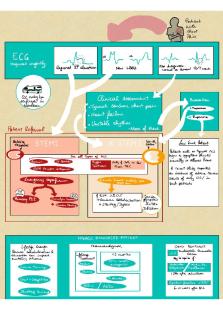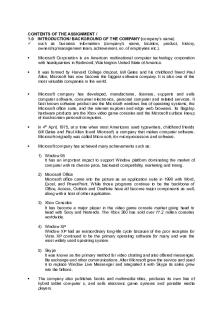Infographic composition 2 PDF

| Title | Infographic composition 2 |
|---|---|
| Author | Ng Hằng |
| Course | Composition II |
| Institution | Arkansas State University |
| Pages | 9 |
| File Size | 585.8 KB |
| File Type | |
| Total Downloads | 9 |
| Total Views | 138 |
Summary
Composition II Infographic Essay...
Description
Vu 1
Hieu Vu Instructor Boozer Composition II April 4th, 2021 Littering Abstract: Even though the cost of littering is intangible, its repercussions are fatal in the long-term period. It is a trigger for many of the problems that several countries like the U.S, VietNam, and Europe suffer; it has sometimes been considered the number one key to habitat deterioration for decades. Discarding plastic products, including grocery sacks, rapidly fills up landfills and often clog drains. These litters will deplete ocean animals' nutrients and blocking their stomachs and intestines. The purpose of this research is to find out the solutions to help my audience aged around 18 to 26, have a better grasp of the zero-waste lifestyle, and understand the long-run cost of littering. However, this plan's problem is to elaborate on our core value about protecting our mother nature and create a simple call-to-action that each follower can immediately implement. Even though it takes practice to embrace a zero-waste lifestyle, I firmly believe that if young millennials have an adept understanding of this, they will have the confidence to make impacts in their way. What is our current situation? When the population increases, so will the amount of litter. According to the World Bank, waste is projected to rise by up to 70% between 2016 and 2050. Every year, the planet produces
Vu 2
nearly two billion tons of municipal solid waste (MSW), enough to fill 822,000 Olympic-sized swimming pools. MSW contains garbage from businesses, buildings, homes, yards, and small businesses. According to the World Bank's database, the United States created the most municipal solid waste of any nation. In total, the United States produced approximately 258 million tons of MSW per year. Everyone in the United States generates around 4.4 pounds of municipal waste per day. This infographic offers us a comprehensive overview of the acceleration of destruction throughout the world.
What is the financial and health cost that we are paying right now? Is it worth keeping doing what we do in the next five years or even ten years?
Vu 3
One threat to our health is ocean plastic's movement up the food chain, a bioaccumulation phenomenon. Since humans are higher up the food chain, we consume higher amounts of plastic and toxic chemicals. This infographic below illustrates the impacts on our bodies that this can have.
Vu 4
Moreover, plastic contamination affects marine life and humans and harms the fishing and aquaculture industries, tourism, leisure, transportation, and other economic sectors. In developing countries, the opportunity cost of littering increases exponentially compared to a developed one.
Why is it imperative to address littering on the social level right now?
Vu 5
As being younger generation, we need to take full responsibility to mitigate this problem. We're living in a delayed-returned environment where our decisions do not affect our life immediately. It's tough to take the drawbacks of littering our mother nature when we throw away our garbage. This infographic is like a mirror that reflects the connection between our current decision and the long-term cost to wildlife. Instead of waiting for the government's help, we can change the world, help our younger generation, and millions of species on this planet by modifying one habit every day.
Vu 6
Why should we leverage social media to develop a strong community and ask for young millennials' support to combat these problematic issues? The last five years have witnessed double growth in the time for young millennials to use social media for entertainment, which indicates that addressing littering should leverage digital marketing techniques and create a strong community where practicing a zero-waste lifestyle is a daily ritual. YouTube and its micro-influencer are those we will focus on. Statista, above 90% of young millennials spent their time on YouTube in 2019, while Facebook and Instagram are roughly 80%.
However, creating a YouTube campaign, building an authentic channel, and developing a solid community for a zero-waste lifestyle is on our network and its quality. Even though combating littering is an old problem, we can incorporate modern music or dance with our message to make it even more lively and easier to spread on social media. Our micro-influencer is an excellent
Vu 7
factor to help us grow, but we need to make sure that we qualify for our core value. Our research wants to transform a zero-waste lifestyle into a brand that each young millennial would love to be part of.
Vu 8
Vu 9
Work Cited Feldman,
Sarah.
"A
World
of
Waste."
Statista.
July
2019.
https://www.statista.com/chart/18732/waste-generated-country/ Mancini. Margot. "Infographic: How Millennials and Boomers View User-Generated Content." Technology for Publishing. https://www.tech4pub.com/2017/01/25/infographic-howmillennials-and-boomers-view-user-generated-content/ "The ugly Journey of Our Trash." Project Aware. https://www.projectaware.org/publication/uglyjourney-our-trash Tarkovsky. H. "U.S Gen Z & Millenials Social Network Penetration 2019, By Gender." Statista. https://www.statista.com/statistics/471543/millennials-usa-social-media-reach-gender/ Vu, Truc. "Action on Plastic Pollution." Sustainable Investment Group. April 2019. https://sigearth.com/action-on-plastic-pollution/...
Similar Free PDFs

Infographic composition 2
- 9 Pages

Infographic Assignment
- 2 Pages

Mindfulness Infographic
- 1 Pages

Infographic MKT558
- 2 Pages

Stigma Infographic
- 1 Pages

Infographic - Activity
- 1 Pages

ACS - ACS Infographic
- 2 Pages

Assignment MGT Infographic
- 3 Pages

Individual Infographic Chapter 7
- 6 Pages

CS-Pathway Infographic
- 1 Pages
Popular Institutions
- Tinajero National High School - Annex
- Politeknik Caltex Riau
- Yokohama City University
- SGT University
- University of Al-Qadisiyah
- Divine Word College of Vigan
- Techniek College Rotterdam
- Universidade de Santiago
- Universiti Teknologi MARA Cawangan Johor Kampus Pasir Gudang
- Poltekkes Kemenkes Yogyakarta
- Baguio City National High School
- Colegio san marcos
- preparatoria uno
- Centro de Bachillerato Tecnológico Industrial y de Servicios No. 107
- Dalian Maritime University
- Quang Trung Secondary School
- Colegio Tecnológico en Informática
- Corporación Regional de Educación Superior
- Grupo CEDVA
- Dar Al Uloom University
- Centro de Estudios Preuniversitarios de la Universidad Nacional de Ingeniería
- 上智大学
- Aakash International School, Nuna Majara
- San Felipe Neri Catholic School
- Kang Chiao International School - New Taipei City
- Misamis Occidental National High School
- Institución Educativa Escuela Normal Juan Ladrilleros
- Kolehiyo ng Pantukan
- Batanes State College
- Instituto Continental
- Sekolah Menengah Kejuruan Kesehatan Kaltara (Tarakan)
- Colegio de La Inmaculada Concepcion - Cebu





